Papa Vinyard here, now here's a little somethin' for ya...
This column will tackle an Oscar winner from each year starting with the inception of the Academy Awards in 1929. My goal is to highlight lesser-known films from throughout cinema history that were able pull down one (or more) of the Golden Statuettes that remain such an integral part of Hollywood lore. I will also take a close look at the actual element(s) that the film was given awards for, with my analysis on how they hold up with years (or decades) of cinematic history in the rearview since. Last week, I made the mistake of announcing that I'd be looking at the 2009 winner for Best Short Film (Animated), Kunio Katou's LA MAISON EN PETITS CUBES. I will instead be looking at the 2010 winner of the award, H5's LOGORAMA. Tune in next week when I'll be reviewing Frank Borzage's 1932 winner for Best Director and Best Adapted Screenplay, BAD GIRL.
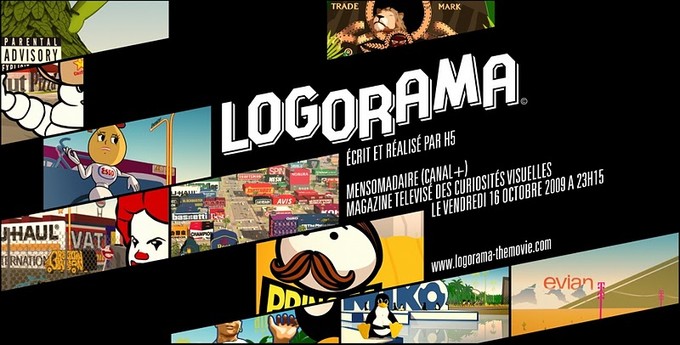
LOGORAMA is, in short, a complete chastisement of contemporary western civilian life. It's basically saying that our existence, from the way we interact to our primal, fundamental perception of reality, is completely dictated by the brands and labels that permeate our everyday life. But this film's aim is irony, not tragedy. The humor is not in how totally, thoroughly, and seemingly permanently owned we are by the corporations and trademarks that we see, interact with, and consume every day. It is how completely and utterly blind and ignorant we are to it all that is the raison d'etre of this particular film, and serves as the source of both its winning satirical humor and its cynically profound sense of alarm.
By the end of the first shot, we get a fairly good idea of where LOGORAMA is heading. We start on the logo for Malibu Rum, before we pull back and see that it's meant to represent a signpost for the actual Los Angeles city of Malibu. We see a truck with the logo for the RV company Cruise America and two houses, one with the words "AMERICAN FAMILY" written on the side and the other reading "BROAN" after the ventilation fan company. So we're talking a short-film expansion of that joke in REPO MAN where all the items are labeled "FOOD", "DRINK", "BEER", etc., with a anti-corporate overtone, right? Well, not so much...
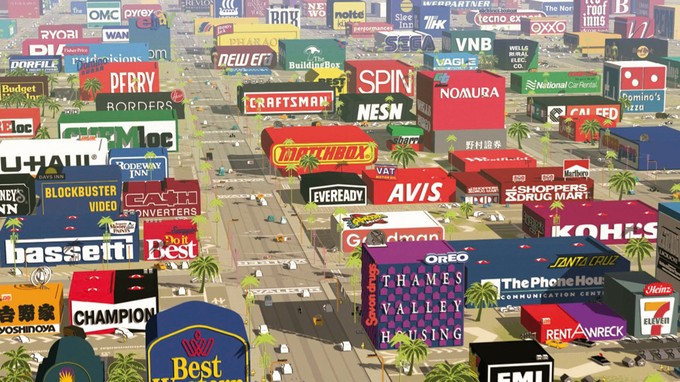
As the piece goes on, we see much more of Los Angeles depicted in this manner, with logos and brand names permeating the architecture, before we settle on the two "cops" (in the guise of Michelin Men) that serve as our protagonists. As the two banter in their squad car ("That cheetah can run like a motherfucker, but in a zoo? He ain't got room to hit second gear!"), we see the dynamic between the two; one's a more happy-go-lucky innocent, the other a grizzled, short-tempered vet. The pair get an A.P.B. on the radio for a suspect described as a "white male, 6-feet-tall, yellow jumpsuit, red hair and shoes, answers to the name Ronald, considered armed and dangerous," (guess who, right?). They look across the street, and who should they see sipping a soda, but Ronald fucking McDonald. "Sweet Jesus!"
A car chase ensues, leading us through a plethora of brand-focused sight gags. A flamboyantly gay Mr. Clean leading the mascots for Haribo and Bob's Big Boy on a tour of the L.A. Zoo that includes the Paramount mountain (a mole hill), a life-sized Republican elephant, and a sleeping lion nestled safely in the round center of the MGM logo. Mr. Peanut getting his head blown off, letting a lone peanut fall out of the hole. A cup of coffee spills on the floor, and the splatter forms the Nickelodeon logo. A couple of M&Ms get run over, spilling candy, chocolate, and peanut center (in that order) onto the car windshield.
Then, right before a police sniper is able to take out the increasingly murderous McDonald, The Big One hits Los Angeles. All the copyrighted characters run for the hills, but many are crushed by the debris. McDonald takes out the grizzled cop with a shot to the head via the gun-barrel James Bond intro framing ("Sorry for killin' you, bro!"). As he takes off in a motorcycle (oddly plastered with the GREASE 2 logo), the rest of the town is smothered in debris, spilled oil, and flooding waters. Only Bob's Big Boy and a mascot for Esso (the international name for Exxon) make it out alive, and enjoy a Steve Jobs Apple atop The North Face (literally the north face of a mountain).
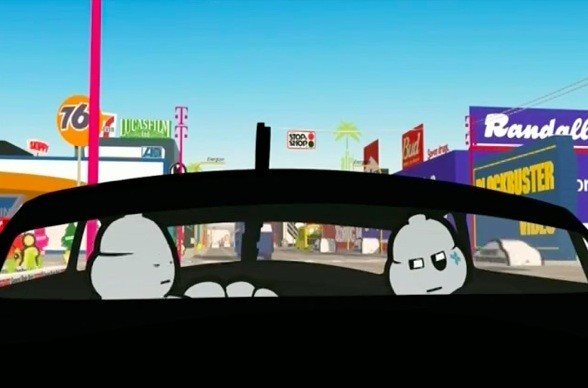
The film could've probably gotten away with being a 2-minute concept short showing a world consisting of logos and brand names, but it would've been less than half as clever, and certainly not Oscar-worthy. The narrative with the raging mad Ronald McDonald, the two policemen, and the various copyrighted bystanders is a half-brilliant idea that makes a simple anti-corporate notion into a layered satire in merely 14 minutes. There is the obvious point that all of us are so inundated by corporate branding that it defines nearly everything we see or do. Skyscrapers are recognized by the offices they house (Colgate, Levi's, Western Union, etc.), a cheap Pizza Hut bench is clearly labeled "Formica", and a truck has GMC splattered in huge letters across its side.
But that's not all. The entire world, from the signposts, to the characters walking around, down to the tiles of the floors are marked with brandnames, most of which have nothing to do with what they are labeled on. A couple of pandas hang out in the Canadian Natural Gas logo. A signpost inexplicably reads THE EMPIRE STRIKES BACK. A storefront has the Jack Daniels label slapped on it (is it the Jack Daniels store? If that exists, can someone get me an address?). The Michelin Men's cop car is labeled "Angelo Cruz" after a Puerto Rican basketball player who went missing in 1997. So the labels that we don't readily associate with the products they aim to represent get arbitrarily assigned to other things. Weird theory. I kinda buy it.
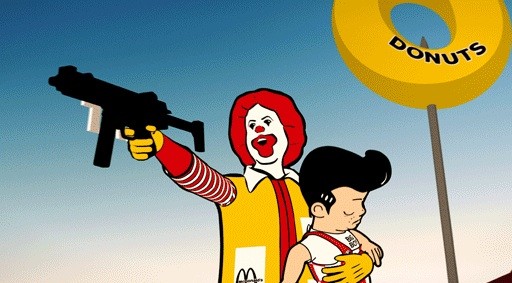
If you want to go even deeper, perhaps even deeper than the filmmakers (Francois Alaux, Herve de Crecy, and Ludovic Houplain) intended, you can examine the significance of Ronald McDonald being the most dangerous icon. It is McDonald who gleefully and randomly machine guns innocent bystanders, and it's he who (indirectly) instigates the destruction of this corporate utopia. I don't think it's any secret that, aside from being the world's biggest fast food company, McDonalds is the leading purchaser of beef and chicken in the U.S., and thus dictates the practices (and pricing) within that industry. Beyond that, they represent the idea of the "quick-fix" corporate mentality, offering its customers something fast, cheap, and easy without even a hint of sustainability. There's a whole fucking documentary devoted to the (entirely true) notion that eating McDonald's can very well kill you, as well as countless docs and news features about the negative impact the company has had on the American agricultural industry.
So…is the inevitable fall of McDonalds going to take the entire world as we know it down with it? If the shoddily-treated cows they raise all die, the beef industry will go under. If the chickens they stack on top of each other like poker chips all get sick, the poultry business will take a massive hit. If the shitty farming methods they endorse become unsustainable, fresh produce may become less common and more expensive. If their economically-unfeasible business practices leaves too large of a carbon footprint, our very atmosphere is in jeopardy. McDonalds may very well kill us all, from the corporate heads to the plebian Big Mac junkies, just by being McDonalds. Maybe that's not what you get from watching a raving Ronald McDonald wantonly causing destruction and mayhem, but it's certainly the message I got. If that's not what the H5 guys were going for, well, that's even more impressive; their intricate construction of this world provoked me into digging deeper than their more obvious surface statements, and that's the mark of truly great art, isn't it?
The dialogue, sight gags, and satirical edge on this one really made an impression on me. It certainly seemed more to me like a wonderful Youtube piece than an Oscar winner for Best Animated Short, but it's to the Academy's credit that they looked beyond the splashy visuals and saw the character and humor underneath. While the flaming homosexual Mr. Clean may be a little crude and un-PC for many Oscar voters, the rest of the film is smart, well-executed, and loaded with detail. You could watch this movie 5 times and still not catch every logo the filmmakers were able to stuff the frames with (I certainly hooted when I caught the EMPIRE STRIKES BACK logo on a repeat viewing).
Oh yeah: David Fincher and Andrew Kevin Walker voice a pair of Pringles tubes. So there's also that.
Logorama from Marc Altshuler - Human Music on Vimeo.
Because the subject I tackled this week was Animated Short, I was able to take a look at the four other nominees and size them up against LOGORAMA. They were:
FRENCH ROAST
This short by is mostly comprised of one shot that pans around and jumps ahead in time, but never leaves its original location. A stuffy French man refuses to relent change to a beggar, but then realizes that he doesn't have his wallet. As he tries to get away with not paying his bill by continuing to order coffee and pinch an elderly lady's wallet, he is continually thwarted, ends up crying at his table. Lo and behold, the beggar ends up paying off his bill. The message is clear; what goes around comes around, so don't be a stuffy asshole and maybe someone will actually be inclined to help you out when you need it.
It's a cute short, simply animated, quickly paced, and very French. Even if the pairing would be a tad on the nose, it would make a great companion piece with RATATOUILLE. However, it pales in comparison to LOGORAMA in that it is mostly a mood piece with a punchline, rather than a fully formed narrative. There's little here beyond what you see at face value, and there's not really a need to see it more than once to get a good look at what it's trying to sell. At a film festival, I could see it easily besting other short films, animated or otherwise (and according to its official site, it did). At the Oscars though? A nomination was probably the best it was ever going to get.
GRANNY O GRIMM'S SLEEPING BEAUTY
An old lady sees that her grandson cannot fall asleep one night, and offers to read the terrified boy the Brothers Grimm's Sleeping Beauty. As the story goes on, it alternates between a jaunty, Disney-esque fairy tale and something more elementally sinister and frightening. Eventually, grandma takes the viewpoint of the old lady villain of the story, and begins to depict the narrative in a brutal, vicious tone that paints the evildoers as righteous and the fairytale kingdom as overprivileged and begging to be taken down. The story ends miserably for everyone, and the grandma leaves the boy in his bed, even more terrified than before.
The story is rendered in 2D, contrasting with the CG bookends with the grandma and the son, and the animation is quite striking. It almost looks like a marionette stage, with the characters looking like flat figures moving left to right on the screen. The CG stuff is well-done, and I love the hairstyles on both characters, but it's a lot less interesting than the 2D animation, maybe by its very nature. Again, beyond the one-joke premise of the grandma sympathizing with the elderly villain and rendering the fairy tale truly grim (ho, ho) and terrifying, the piece doesn't have much going on in terms of content. It's got the style down, and is fleetingly cute, but doesn't really make a lasting impression.
Having said that, if writer/performer Kathleen O'Rourke did a whole series of Granny O'Grimm's fairy tales (there were two other shorts made with the character, although much briefer), I must admit I'd be inclined to check them out.
THE LADY AND THE REAPER
Surely enough, as the title would imply, this short has an elderly lady being taken to the afterlife by Death himself. She misses her late husband, and accepts her fate willingly. Unfortunately, modern science is such that she keeps being resuscitated, leading Death and the woman's doctor in a literal tug-of-war for her soul. Death eventually chases the doctor (and his lovely nurses) through the annals of the hospital, and literally snowballs into a spiral into oblivion that forces death to give up, leaving the woman alive and pissed off at her savior.
The melancholy subject matter creates a great contrast with the more spirited nature of the animation (as well as the cocky good looks of the doctor and his staff), and the slapstick humor makes the tragic implications of the narrative not only palatable, but more poignant. It is like a Bugs/Elmer or Road Runner/Wile E. Coyote cartoon, except the person being chased is actively trying to die and meet their loved one in the afterlife. It's funny, moody, and has striking animation (not to mention Antonio Banderas amongst its producers). But it doesn't really have the subtext of LOGORAMA, and although it certainly achieves what the filmmakers were shooting for, it isn't anything I'll be showing the kids years from now or anything. Still, it's funny, dark, and absolutely worth a look-see.
The lady and the reaper from Hormoz Zamanpour Siahkal on Vimeo.
WALLACE AND GROMIT: A MATTER OF LOAF AND DEATH
And now we get to longest piece nominated that year: clocking at just shy of half-an-hour is Aardman production's WALLACE AND GROMIT short, A MATTER OF LIFE AND DEATH. It was the fourth W & G short film, the latest one to date, and the first one made since the release of the CURSE OF THE WERE-RABBIT feature film. Like the others, it was directed and co-written by Nick Park, features Peter Sallis as the voice of the befuddled Brit Wallace, and was completely made with stop-motion claymation.
This one has the titular man and dog duo running a bread bakery and getting involved with a competing baker with Wallace in her sights. Things get a little dark, and Gromit has to keep the ever-clueless Wallace out of harms way. The film is another Aardman success. The sight gags are cleverly executed, the characters are as charming as ever, and, of course, the animation is unbelievably expressive. It's crazy what Park and his people are continually able to get out of their limitless supply of molding clay and paint. I really wish there was more of a market for this type of film than the TURBOs and FREE BIRDS with their disposable (if meticulous) CGI.
I laughed quite a few times during the short, and the typical Wallace and Gromit charm worked on me as always, but I think this one may be a tad too long for its own good. Maybe we've been spoiled by the feature-length adventures of the two because of CURSE OF THE WERE-RABBIT, but I didn't think that this baker-murderer and her guilty-conscienced dog were worthy of a half-an-hour-long short. There's personality, humor, and truly incredible animation on display, and although it is not as socially or culturally relevant as LOGORAMA, I could easily have seen it going the other way and having this film won the Oscar instead (especially considering that the CURSE OF THE WERE-RABBIT as well as previous W & G shorts THE WRONG TROUSERS and A CLOSE SHAVE all landed awards). It's just…I've seen a bunch of these before. I don't think I'd ever seen anything quite like LOGORAMA. That surprise factor goes a long way. But that's not a knock on this short.
A Matter Of Loaf And Death from short clips on Vimeo.
So yeah, if I have to make a judgement with almost four years in the rearview, I'd say that in my opinion, the Academy made the right call on this one. While all of the shorts have impressive qualities, and some with moments and images that are truly striking and memorable, LOGORAMA really does seem to have the most going for it. The subject matter is relevant and universally identifiable (there's a bunch of foreign brand names in there, but I don't think anything is confusing). The satire is layered, and goes way beyond the easy target of the colorful corporate branding that permeates its landscape. The animation style, amalgamating all these different styles of imagery, font, and coloring, is dynamic, unique, and surprisingly detailed. I'll be calling back to this in future conversations about the impact of corporate branding, and I am in agreement with the Academy that it was the Animated Short most deserving of its legacy as an Oscar winner that year.
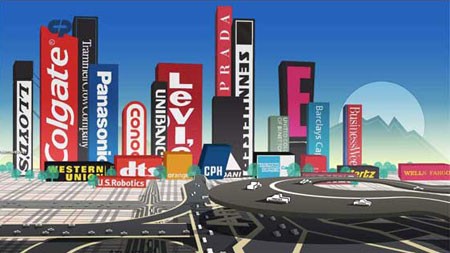
PREVIOUS ENTRIES:
UNDERWORLD (1927): Best Writing (Original Story)
SEARCHING FOR SUGAR MAN (2012): Best Documentary
THE BROADWAY MELODY (1929): Best Picture
THE IRON LADY (2011): Best Actress
THE BIG HOUSE (1930): Best Writing, Best Sound Recording
IN A BETTER WORLD (2010): Best Foreign Language Film
TABU (1931): Best Cinematography
-Vincent Zahedi
”Papa Vinyard”
vincentzahedi@gmail.com
Follow Me On Twitter
